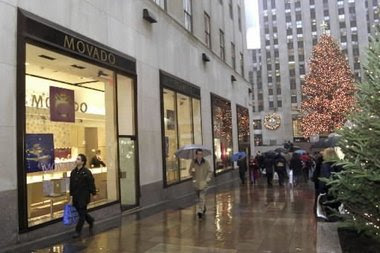 |
| The Movado Rockefeller Center store, the only Movado boutique left in the Movado Group's restructuring plan. |
The Movado Group said Thursday that net sales of its watches in the second quarter of fiscal 2012 increased 32.6 percent, year-over-year, to $113.2 million. On a constant dollar basis, net sales increased 25.5 percent compared to the prior year period. Income from continuing operations was $4.4 million, compared to loss of $3.2 million during the same period of the prior year.
“Our brands continue to experience very strong customer and consumer demand,” Rick Cote, Movado president and COO, said in a conference call with investors and media. “We continue to experience pressure on our gross margins due to a devaluing U.S. dollar versus the Swiss franc as well as product cost pressures. However, we have been able to offset these impacts with strong sales growth and our disciplined expense management growth.”
Movado Group, Inc. designs, manufactures and internationally distributes watches through its brands: Movado, Concord, Ebel and ESQ by Movado. In addition, it has licensing agreements for produce watches under the Coach, Hugo Boss, Juicy Couture, Lacoste and Tommy Hilfiger brands. The company is headquartered in Paramus, N.J., and Bienne, Switzerland, and has a manufacturing facility in Switzerland.
The company is in the midst of a multiyear plan to improve its profitability. Last year, it closed its boutiques (except for its New York's Rockefeller Center store) and is now focusing on its Movado and licensed brands, offering new products and expanding into China.
So far it seems to be working as the company experienced its second consecutive quarter of growth following losses in 2009 and 2010. Cote said all Movado brands experienced strong growth, in particular its Movado brand and licensing brand division. The China market grew by more than 50 percent in the first half of the year.
“While we experienced broad-based sales growth across all of our brand categories, our results continue to be driven by particularly strong performances in Movado and licensed brands both domestically and internationally,” Efraim Grinberg, Movado chairman and CEO, said in a statement.
Net income for the quarter, ended July 31, was $4.4 million, compared to a net loss for the second quarter of fiscal 2011 of $20.9 million, including the results of discontinued operations of $17.7 million. Operating income increased to $5 million in the second quarter of fiscal 2012 compared to operating loss of $2.2 million for the same period last year. EBITDA increased to $8 million compared to EBITDA of $1.5 million in the second quarter of fiscal 2011.
The company also reiterated its prior guidance for fiscal 2012 and continues to anticipate that EBITDA will range between $31.5 million and $33.5 million for the year and that net income will be in the range of $15 million to $16.5 million.
Grinberg said during the conference call that he expects sales to be better than first anticipated but but gross margins will “not be as anticipated,” due to the imbalances between the Swiss franc and the U.S. dollar and rising manufacturing costs.
“I think the top line will be a little better than what our guidance had been but when we’re done we see that positive being offset by some of the gross margin negatives,” he said. “That’s why we still see the bottom line in the range that we have given previous guidance on. Sales will be at the upper echelon and a little bit better and the gross margin will not be where we had originally anticipated.”
Gross profit for the company was $60.9 million, or 53.8 percent of sales, compared to $44.4 million, or 52 percent of sales in the second quarter last year, primarily due to the leverage gained on fixed costs and a favorable shift in channel and product mix, the company said.
Operating expenses rose 20 percent to $9.3 million due to increased marketing expenses to drive sales, salary increases, the reinstatement of certain employee benefits and performance-based compensation, the company said. In addition, there was an increase due to unfavorable foreign currency exchange rates (again, referring primarily to the rates between the Swiss franc and the U.S. dollar).





